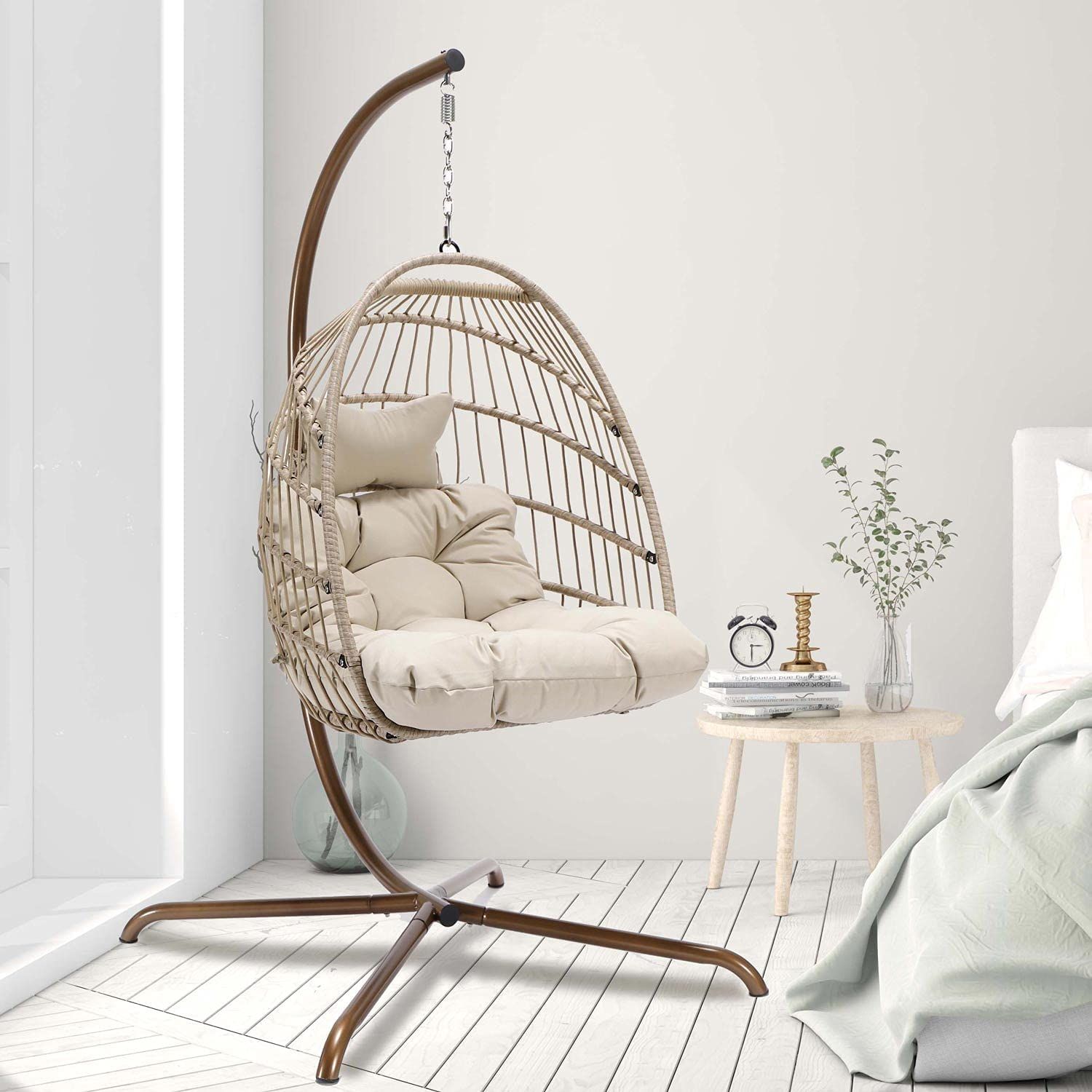Repurposing Existing Furniture for a Unique Hanging Egg Chair
One approach to DIY hanging egg chair projects is to repurpose existing furniture to create a unique and personalized chair. This perspective emphasizes creativity and resourcefulness, allowing individuals to transform old or unused pieces into functional and stylish hanging egg chairs.
Start by selecting a sturdy base for your project, such as a wooden or metal chair frame. Consider chairs with a wide seat and a solid structure that can support the weight of the hanging egg chair. Remove the legs or any unnecessary components, leaving a sturdy foundation for your creation.
Next, you can focus on creating the egg-shaped enclosure. One option is to use a large wire basket or a metal hoop as the frame. Attach it securely to the chair base, ensuring stability and balance. You can then cover the frame with materials like rattan, wicker, or even fabric, using adhesive or zip ties to secure them in place.
To enhance comfort, consider adding cushions or padding to the seating area and backrest. You can sew or repurpose existing cushions to fit the shape of the chair, ensuring a cozy and inviting seating experience.
Constructing a Wooden Hanging Egg Chair from Scratch
For those with woodworking skills, constructing a hanging egg chair from scratch provides an opportunity to create a truly one-of-a-kind piece. This perspective focuses on craftsmanship and precision, allowing individuals to fully customize the chair’s size, shape, and design.
Begin by gathering the necessary materials, including high-quality wood, screws, and hardware for assembly. Sketch out the design and dimensions of your hanging egg chair, taking into account comfort, weight capacity, and aesthetic preferences.
Start by building the base and frame of the chair, ensuring that it is stable and can support the weight of the enclosure. Use appropriate joinery techniques, such as mortise and tenon or dowel joints, to ensure structural integrity. Next, construct the egg-shaped enclosure, taking care to create a design that provides both comfort and visual appeal.
Consider adding a sturdy hanging mechanism, such as a metal chain or rope, to securely suspend the chair. Ensure that the hanging mechanism is properly attached to the frame, allowing for smooth and safe movement.
Once the basic structure is complete, you can focus on finishing touches. Sand the wood surfaces to achieve a smooth texture and remove any rough edges. Apply a protective finish, such as varnish or outdoor sealant, to enhance durability and weather resistance.
Macramé Hanging Egg Chair for a Bohemian Vibe
Macramé, the art of knotting cords into intricate patterns, offers a unique and bohemian approach to DIY hanging egg chair projects. This perspective embraces creativity and craftsmanship, allowing individuals to create a stunning, handmade chair with a touch of vintage charm.
Start by gathering sturdy ropes or cords suitable for macramé. Choose a thickness and material that can support the weight of the chair and withstand regular use. You’ll also need a metal or wooden hoop to serve as the frame and a hanging mechanism like a metal chain or rope.
Begin by creating the seat and backrest using various macramé knotting techniques. Explore patterns such as square knots, half hitch knots, or lark’s head knots to create intricate designs and textures. Follow tutorials or experiment with your own knotting patterns to achieve the desired shape and structure.
Once the seat and backrest are complete, attach them securely to the frame using additional knots or connectors. Ensure that the chair is well balanced and the hanging mechanism is properly attached for safe suspension.
PVC Pipe Hanging Egg Chair for Affordability and Durability
For those looking for an affordable and durable DIY hanging egg chair option, using PVC pipes as the primary material offers a practical and accessible approach. This perspective emphasizes simplicity, cost-effectiveness, and longevity, making it ideal for beginners or individuals on a budget.
Start by gathering PVC pipes and fittings in suitable sizes for the chair’s frame. PVC pipes are available in various diameters and lengths, allowing you to customize the size of the chair to fit your space and preferences.
Construct the chair frame by cutting the PVC pipes to the desired lengths and connecting them using appropriate fittings. You can use connectors like elbows, tees, and caps to assemble the frame securely. Consider reinforcing the joints with PVC adhesive or screws for added stability.
Once the frame is complete, you can create the egg-shaped enclosure by using additional PVC pipes or flexible materials like fabric or netting. Attach the enclosure to the frame using zip ties or adhesive, ensuring a secure and snug fit.
To provide a comfortable seating experience, consider adding cushions or padding to the seat and backrest. You can create custom-sized cushions using foam and fabric, or repurpose existing cushions to fit the chair’s dimensions.
PVC pipe hanging egg chairs are known for their durability and resistance to weather conditions. However, for added protection and aesthetics, consider painting the PVC pipes using appropriate spray paint designed for plastic materials.
